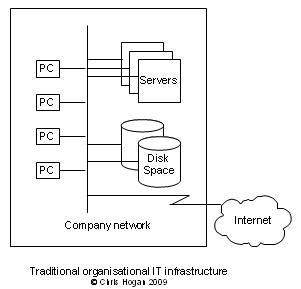Infrastructure as a Service
Definition: Infrastructure as a Service (IaaS) describes one of the
three main methods of accessing cloud computing based services. Organisations
rent computing power and disk space and access them from desktop PCs through a
private network or across the internet.
| |
|

|
Placing IaaS in the Cloud Computing Model
IaaS has its roots in thin computing techniques that have been developing since
the mid 1990s. But it was not adopted widely until virtualisation and fast,
reliable and widespread internet access made it workable.
Cloud
computing in general refers to the idea that a company can rent space from a
service provider and use it across the internet rather than having an IT
infrastructure on their own premises.
There are broadly three varieties of cloud computing offerings, Software as a
Service (SaaS) and Platform as a Service (Platform) being the other two. As all
these services are still developing quickly the definitions and divisions
between these varieties are nebulous at best and constantly shifting. There is
considerable overlap in particular between IaaS and PaaS, and a service might
find itself described as either of these depending on whether the description
comes from a developer, system admin or a manager.
Description of IaaS
 With IaaS the enterprise renting the service is likely to have considerable IT
skills in-house because the infrastructure offered is quite plain. Customers
select and basic
software servers for their part of the
cloud and then load up their libraries, applications and
data then configure them themselves. Virtualisation enables IaaS providers
to offer almost unlimited instances of servers to customers and make
cost-effective use of the hosting hardware. With IaaS the enterprise renting the service is likely to have considerable IT
skills in-house because the infrastructure offered is quite plain. Customers
select and basic
software servers for their part of the
cloud and then load up their libraries, applications and
data then configure them themselves. Virtualisation enables IaaS providers
to offer almost unlimited instances of servers to customers and make
cost-effective use of the hosting hardware.
Organisations can use IaaS to quickly build new versions of applications or
environments without having to order new hardware then wait for it to arrive and
be configured. Another popular use of IaaS is hosting the websites of
organisations. This keeps the website and its drain on IT resources away from an
internal infrastructure whose primary purpose is to run the business, not the
website. In these instances the IaaS provider takes on any worries about
monitoring traffic and keeping the website available.
Cost Comparisons for IaaS Providers
Like most
cloud
computing service offerings IaaS is priced on a pay-as-you-go model, with
organisations paying for the services provided from a menu. There is usually a
price for the number of 'instances' of servers, either Windows or Unix, and the
software environments loaded onto them such as
databases or web severs,
application development environments or others. Then charges are made for
the amounts of data hosted and network traffic in and out of the servers.
The pricing models vary from provider to provider which makes it difficult for
organisations considering a move to IaaS to compare providers against each
other. The varying usage rates of different computing environments also conspire
against organisations trying to compare prices. An organisation looking to
outsource a high volume website might find that one provider is cheaper but that
same provider may be more expensive for a company outsourcing its development
environment, which would require higher computing power but much lower data
transfer rates. Comparisons also need to be made between the whole cost of
owning servers and storage rather than renting them from an IaaS provider.
A Real Life IaaS Provider Example
Amazon Web Services (AWS) is the most
successful IaaS provider to date. Amazon has huge server farms that support the
Amazon website and plenty of experience with running a reliable multiple server
operation. It was decided to take the skills, technologies and hardware they had
developed or acquired and offer them for hire to other organisations.
Amazon's Elastic Compute Cloud (EC2) offers, as the name suggests, server power
that can grow and contract in line with an organisation's demands. Users of the
service pay (at the time of going to press) ten cents (USD) per hour for the
most basic server and the menu goes up from there. This offers a lot to startups
or small businesses who can then afford to access server and storage capacities
that would otherwise drain vital capital.
Considerations for Organisations Considering IaaS
Significant thought should be given before any organisation shifts from an
internally hosted infrastructure to IaaS. The usual argument for cloud computing
versus buying your own is lower costs and the removal of the IT management
headache. With IaaS this is not so clear cut as you have to retain IT staff to
develop and manage the software and applications that sit on top of your rented
infrastructure. That has a knock on effect on the cost argument as there are
fewer significant salary savings.
Other considerations for organisations considering a move to IaaS include a
detailed examination of the contract and terms of service. Being tied in to any
one service is a risk for businesses, as is handing over their data to someone
else to look after. Contracts should be examined for tie-in periods and
penalties for withdrawing early from an arrangement if it proves unsatisfactory.
Data Protection and Service Level Agreements (SLAs)
As with any other strategic partner,
due
diligence should be performed on the IaaS provider. Assess their financial
situation and stability and examine their service level agreements to make sure
they have thought about service provision and its management. Make sure also
that those SLAs are backed up with hardware and network resilience and
backups for data and applications.
Look closely too at the provisions for keeping data safe from theft or being
compromised in some other way. This is perhaps the biggest barrier to the
adoption of IaaS and other cloud computing based services, although many
companies and academic research projects are working at better ways of ensuring
data privacy and integrity.
|

 With IaaS the enterprise renting the service is likely to have considerable IT
skills in-house because the infrastructure offered is quite plain. Customers
select and basic
With IaaS the enterprise renting the service is likely to have considerable IT
skills in-house because the infrastructure offered is quite plain. Customers
select and basic